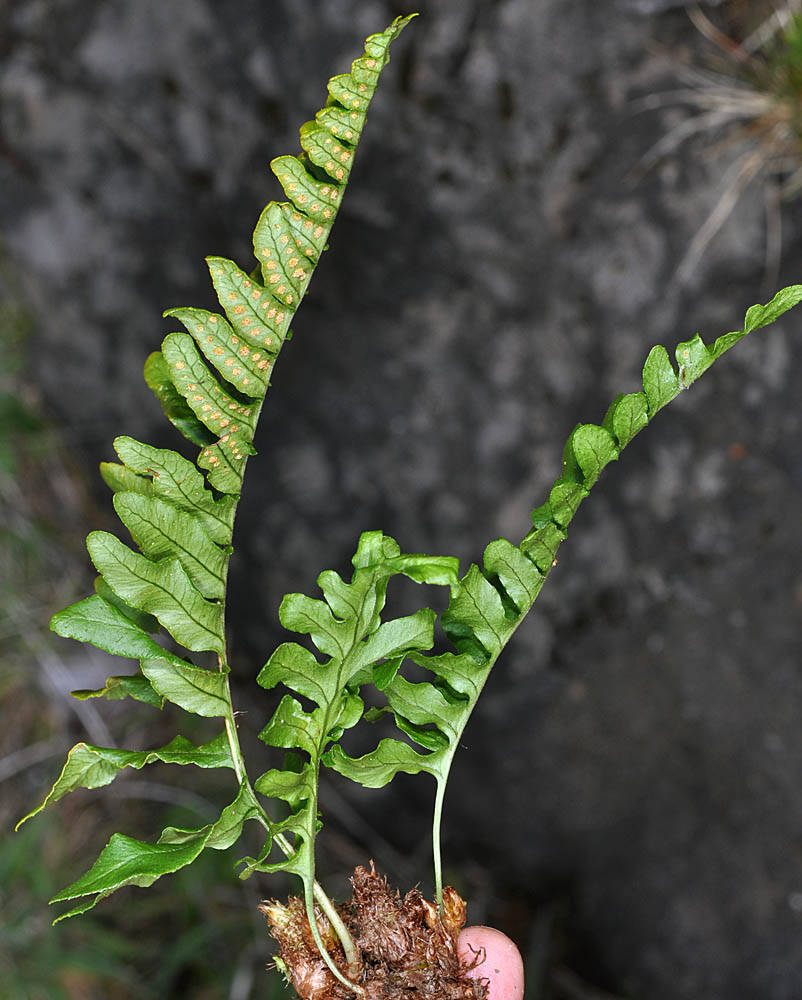
Stems moderately stout, often white-pruinose, with dense brown lanceolate scales; taste slightly bitter and lacking strong licorice flavor.
Leaves to 30 cm long; petiole slender, to 13 × 0.2 cm, smooth.
Blades pinnatifid, to 18 × 8 cm, narrowly ovate to oblong, often slightly leathery; adaxial surface pubescent with whitish multicellular hairs (at least along rachis); lanceolate scales usually present on abaxial surface of rachis, usually more than 3 cells wide.
Pinnae narrow, lanceolate to oblong, to 3 × 0.6 cm; margin serrate; apex usually acute, not long-attenuate; veins anastomosing or not, forming areolae on some pinnae.
Sori less than 3 mm; sporangiasters absent.
2n=148.
On cliffs and rocks/gravel near the coast. 0–200 m. Est. CA; south to northern Mexico. Native.
as described under Polypodium calirhiza
Stems rarely whitish to glaucous, moderately stout to slender, to 8 mm diam., acrid- or slightly sweet-tasting; scales concolored brown or slightly darker near point of attachment, lanceolate-ovate, symmetric, margins entire to erose. Leaves to 70 cm. Petiole usually slender, to 3 mm diam. Blade lanceolate-ovate to oblong, pinnatifid, widest below middle or occasionally at base, to 16 cm wide, leathery to herbaceous; rachis sparsely scaly to glabrescent abaxially, puberulent adaxially; scales lanceolate-ovate, usually more than 3 cells wide. Segments linear-lanceolate to oblong, usually less than 15 mm wide; margins conspicuously serrate; apex obtuse to acute; midrib puberulent adaxially. Venation weakly to moderately anastomosing, some to many segments lacking areoles. Sori midway between margin and midrib or slightly closer to midrib, usually less than 4 mm diam., oval when immature. Sporangiasters absent. Spores more than 58 µm, verrucose, surface projections less than 3 µm. 2 n = 148.Sporulating winter--summer. Cliffs and rocky slopes, sometimes epiphytic; on a variety of substrates but usually on granite or other igneous rocks; 0--1500 m; Calif., Oreg.; Mexico.Although originally considered a cytotype of Polypodium californicum , P . calirhiza is an allotetraploid involving P . californicum and P . glycyrrhiza (S. A. Whitmore and A. R. Smith 1991) and therefore should be treated as a distinct species. Some individuals of P . calirhiza can be difficult to distinguish from the two parental species (see comments under P . californicum and P . glycyrrhiza ); most collections can be identified based on a combination of blade shape, venation pattern, spore size, and geographic distribution. Polypodium calirhiza hybridizes with P . glycyrrhiza to produce sterile triploid plants with misshapen spores.